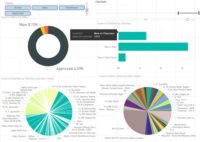As professionals who work in program, project and construction management, much of the work we do is fundamentally the same as it was three decades ago—even though we have invested in new tools and automated processes to help us and our clients stay ahead of the competition. Yes, many of us have embraced new technologies to do our work, but, compared with the technology-driven change in the world at large, our improvements have been incremental and small.
Evolve or Else
That leaves us with two choices: Step up the pace, or fall fatally behind.
Stepping up the pace means coming from behind, which is good as it means we have examples to follow. The world in which we operate is in transformation, and we should look at what’s happening for guidance to the future, rather than wait like the canary in the coal mine that signals the arrival of change by falling quiet and keeling over dead. Project and construction management firms would be wise to embrace technologies supporting automation, integrated project delivery, and new skills creation.
We have already seen how the adoption of technology-supported processes has led to a decrease in data-entry time for project documentation. For our industry, improvements in administrative efficiency have an out-sized impact. Our clients will not require us to manage document controls processes when project documentation is an automated byproduct of a completed workflow whose data courses into a system where it can be captured, sorted, archived, analyzed and reported without human intervention.
Technological advancements are helping owners and developers use more integrated design and construction solutions. The increasing use of such project delivery methods aligns incentives of entire project teams and stakeholders and facilitates collaboration. Also notable is the rise of new services and vendors coming into construction, bringing manufacturing and supply-chain expertise to help project and construction managers deliver (to owners) true turn-key, facility solutions.
Leaving Behind What You Have... For What You Might Receive
But to get to the future, you have to let go of the past. Tomorrow’s project managers must question traditional methods and welcome technological advances. To stay ahead of the industry through innovation, professional services teams, like ours at Gafcon, are embracing program management information systems (PMIS), building information modeling (BIM), virtual design and construction (VDC), business intelligence and reporting tools, geographical information systems (GIS), reality capture, the internet of things (IoT), digital twins, virtual reality (VR), and augmented reality (AR) while rolling all that up to support the delivery of data services to owners.
The PM and CM business model can only succeed by establishing and maintaining credibility with owners. But many firms are also stuck with the idea that credibility can only be built on personal relationships and the delivery of high-quality leadership services as the bridge between clients and projects. That’s important, of course, but it is not enough, and those that think so will soon be shaken as the technology paradigm shifts. It will not be easy to establish and maintain credibility with clients if you do not have the technology resources and expertise to deliver the new services required. With most PM and CM firms already operating with lean benches and low overhead, their ability to lead within this changing digital environment will be key to survival.
Digital transformation is one way to avoid the fate of the coal mine canary, and the roadmap to digital transformation is as plain as the story of Netflix, which embraced technology to transform its CD- and U.S. Mail-based product delivery model with digital streaming, pulling rapidly ahead of its competition in the process. It’s a perfect example of the churn of businesses, services and products rising and falling as a result of innovation and progress that’s known of as “creative destruction,” a term coined by economist Joseph Schumpeter in 1943. It has never been better exemplified than by Netflix over the last two decades.
With more than 32 years in this business, we here at Gafcon are trying to proactively anticipate how technology will enable the PM and CM roles to evolve in the next decade. Understanding the concept of creative destruction has helped us plan our strategy to sustain, protect and grow our enterprise in this changing business climate, and it can help the rest of the construction industry ensure its future too.
A Very Rough Road That Also Leads to Creation
PM and CM firms are in the business of solving problems. They design custom engagements based on a client’s requirements, but in a technology-driven future, those owners’ representatives will need a flexible and diverse skill set that relies less on individual and personal relationships with clients and more on best practices that can be standardized and scaled with new technology. At our firm, we have built operational templates and “Centers of Excellence” to capture and disseminate best practices, as well as provided stand-alone service offerings such as design review, estimating, and scheduling. This approach allows us to capitalize on new efficiencies, instead of struggle to fit antiquated practices into new systems.
We also make the development of technology expertise within our team a priority. This is especially critical as process automation, enabled by systems, increasingly is becoming the norm — and not the exception — on projects. The ability to swiftly curate new tools and design solutions that work for an owner’s unique program or project requirements is already becoming a critical component of PM and CM offerings. Even for owners with legacy systems, our ability to assess, optimize, and integrate their systems with new, more efficient technologies, provides more value to our clients than just staffing up to plow along with outdated solutions.
We have taught ourselves to look beyond the tried and true and are breaking down the silos within project teams to create a unified approach – meaning fewer man-hours, fewer change orders, lower cost, and better products.
Different Ways of Working
Finally, we are practicing acceptance of more fluid business relationships. The logical conclusion of the increasing overlap of services is “coopetition” (cooperative competition) with our clients or within the project teams we manage. This trend already is underway among other participants in the industry. General contractors self-perform more work than ever, proactive architects are becoming developers, and manufacturers are providing modular system solutions directly to the end clients. We have forged new types of partnerships with developers, designers and contractors in unique business opportunities. We’ve performed design services on international projects, and are actively exploring development opportunities.
For now, all of these developments are optional choices, but not for much longer. The canaries are dying, but the phoenix, that symbol of triumphant renewal, is rising.
Destructive rebirth is never easy. But just as strain is often the secret ingredient to innovation, the future success of PM and CM firms will depend on whether they have the courage to climb atop that pile of tinder, and light the match.
Sean Olcott is technical director for virtual design and construction platforms at the owners representative firm Gafcon, Inc., where he advises on technology strategy and implements solutions for a diverse group of clients on more than $20-billion worth of capital projects.





Post a comment to this article
Report Abusive Comment